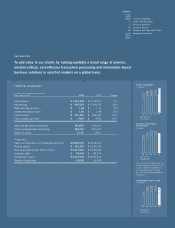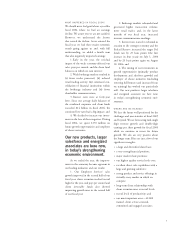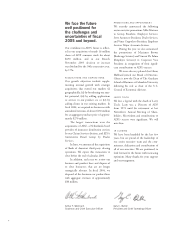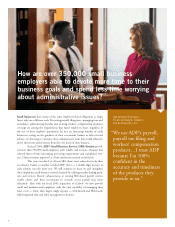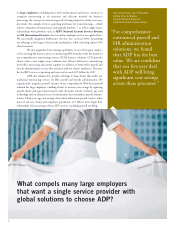ADP 2004 Annual Report Download - page 5
Download and view the complete annual report
Please find page 5 of the 2004 ADP annual report below. You can navigate through the pages in the report by either clicking on the pages listed below, or by using the keyword search tool below to find specific information within the annual report.3
WHAT HAPPENED IN FISCAL 2004?
We should never feel good about a year like
fiscal 2004 where we had an earnings
decline. We assure you we are not satisfied.
However, we understand the factors
that caused the decline. As we entered the
fiscal year, we had three major economic
trends going against us and, with full
understanding, we added a fourth item
that also negatively impacted earnings:
1. Early in the year, the residual
impact of the weak economy affected our
sales, pays per control, and the client fund
balances on which we earn interest;
2. Weak brokerage markets resulted in
(i) fewer trades processed, (ii) reduced
retail trading activity, (iii) continued con-
solidation of financial institutions within
the brokerage industry and (iv) fewer
shareholder communications;
3. Interest rates were at forty-year
lows. Since our average daily balances of
the combined corporate and client funds
exceeded $14 billion in fiscal 2004, the
continued low rates had a big impact; and
4. We decided to increase our invest-
ment in the face of these negatives. During
fiscal 2004, we spent $170 million on
future growth opportunities and employer
of choice initiatives.
2. Brokerage markets rebounded and
generated higher transaction volume,
more retail trades, and, in the latter
months of our fiscal year, increased
investor communications mailings;
3. Interest rates started to rebound in
reaction to the stronger economy and the
Federal Reserve increased the target Fed
funds rate by 25 basis points (the first
increase in four years) on July 1, 2004
and by 25 basis points again on August
10, 2004; and
4. The timing of our investments in
growth opportunities (primarily product
development and salesforce growth) and
employer of choice initiatives (including
restoring full bonuses and increased focus
on training) has worked out particularly
well. Our new products, larger salesforce
and energized associates are here now,
in today’s strengthening economic envi-
ronment.
WHERE ARE WE HEADED?
We face the future well positioned for the
challenges and uncertainties of fiscal 2005
and beyond. We are forecasting mid-single
digit revenue growth and double-digit
earnings per share growth for fiscal 2005
while we continue to invest for future
growth. We also are very positive about
the longer term. Here are just a few of our
significant strengths:
> a large and diversified client base;
> a very strong financial position;
> major market share positions;
> our highest quality service levels ever;
> excellent direct sales capabilities with a
large and growing salesforce;
> strong product and service offerings in
virtually every market in which we
compete;
> long-term client relationships with
client retention rates at record levels;
> record levels of productivity; and
> our most important asset – 42,000
trained, client service-oriented,
committed and engaged associates.
Our new products, larger
salesforce and energized
associates are here now,
in today’s strengthening
economic environment.
As we ended the year, the improve-
ment in the economy became apparent in
our leading indicators and our results:
1. Our Employer Services’ sales
growth improved in the second half of our
fiscal year, client retention reached record
highs for the year, and pays per control and
client investable funds also showed
improving growth rates in the second half
of our fiscal year;


